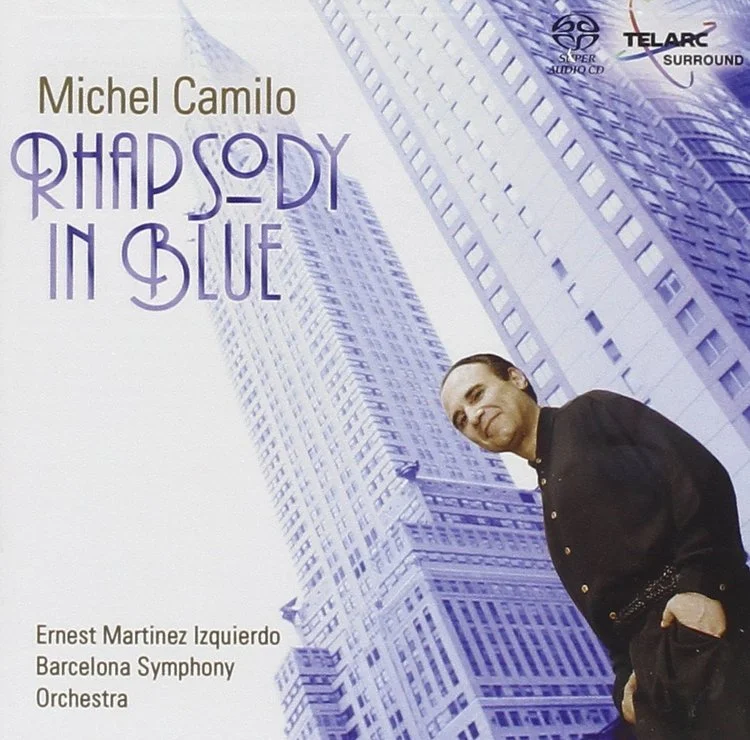TRACKLIST
Rhapsody in Blue
Concerto in F Allegro
Adagio - (with Andante)
Allegro Agitato
Prelude No. 2
album notes
“Classy and nostalgic as ever, Michel’s ‘Rhapsody’ has a new flavor, thanks to the master pianist’s signature style—equal parts fiery, creative abandon and meticulous, technical precision.” - Raul da Gama
While the earliest roots of jazz run deep in the African American blues experience, the music would not be what it is today if not for the vast wave of immigrants who grafted their musical and cultural sensibilities to the burgeoning art form during the early decades of the 20th century. One of the most important names in this early chapter of the jazz story is George Gershwin. Born to immigrant parents in Brooklyn, NY, in 1898, Gershwin’s deep European roots enabled him to marry the Old World with the New and redefine American jazz in a way that no musician had ever done before.
Fast forward several decades to the late 1970s, when Michel Camilo, a young pianist from the Dominican Republic, arrived in that same culturally vibrant New York that welcomed Gershwin’s parents in the late 1800s. Camilo’s career-long love affair with American jazz in general and Gershwin in particular is at the heart of Rhapsody in Blue, a new Telarc recording set for release on February 28, 2006. The album pays homage to Gershwin with the help of the 95-piece Barcelona Symphony Orchestra (Orquestra Simfònica de Barcelona i Nacional de Catalunya), conducted by Ernest Martinez Izquierdo.
On the heels of two of his finest recordings to date—the Grammy winning Live at the Blue Note (2003) and the intimate Solo (2004) Camilo’s newest effort on Telarc seamlessly merges jazz and symphonic sensibilities with a unique rendition of Gershwin’s immortal “Rhapsody in Blue,” followed by some of the great American composer’s lesser known work—his Concerto in F, followed by his Prelude No. 2 for solo piano, with a touch of improvised blues.
“I’m a big admirer of Gershwin. I always have been,” says Camilo, who has included Gershwin music in his stage and studio repertoire since the earliest days of his career. “The reason is because he pushed all the boundaries from one musical world to another, and he did it with no fear. I have been trying to do the same with my career, going from jazz to film scores to world beat experiments to guest solo performances with symphony orchestras.”
Fernando Gonzalez, managing editor of Jazziz magazine and author of the Rhapsody in Blue liner notes, takes the comparison a step further. “Like George Gershwin before him, Camilo is an irrepressible New World romantic,” says Gonzalez. “Both his music and his playing are open faced, generous, and ambitious, full of energy and brash optimism.” For Camilo, the project was all about preserving the freshness and immediacy of Gershwin’s music—no small feat with 95 other musicians playing along. “There’s a certain spontaneity that I wanted to capture in this music. I discussed this with Ernest and the orchestra, and we all went after that magic,” says Camilo. “I didn’t want it to sound too formal, but instead a little bit wild…With music like this, a performer will often ‘play the ink,’ which means playing the notes that Gershwin wrote for the piano part. But I tried to make it sound like I was improvising by taking some liberties, although I was playing the ink. That was the spirit I was trying to capture.”
Would Gershwin approve of a 21st century jazz interpretation of his work? Gonzalez has little doubt. Michel Camilo’s Rhapsody in Blue “is a streetwise approach to Gershwin’s work,” he says. “Respectful but not reverential, exact but also swinging, classical in form but jazz in spirit—that would have done Gershwin proud.”
